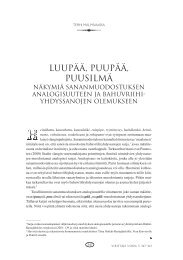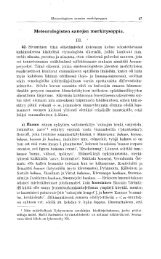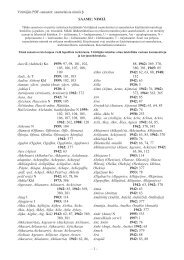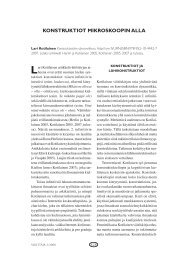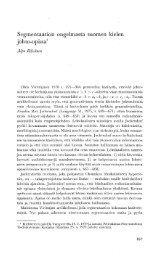pdf-tiedostona - Kotikielen Seura
pdf-tiedostona - Kotikielen Seura
pdf-tiedostona - Kotikielen Seura
Create successful ePaper yourself
Turn your PDF publications into a flip-book with our unique Google optimized e-Paper software.
the influence of the transitive sentences<br />
which served as a model is still reflected.<br />
In relation to the resultative verb<br />
governing it the object is equally nonagentive<br />
as the subject of an existential<br />
sentence is in relation to a predicate verb<br />
(including also sentences such as Pihalla<br />
juoksee poikia 'there are boys running in<br />
the garden' in which the inherent agentivity<br />
of the subject has been embedded<br />
in the collective event of the locality).<br />
The fact that intransitive non-agentive<br />
sentences of this type are continuously<br />
associated with resultative transitive<br />
sentences with similar topic/comment<br />
relationships seems to have had an important<br />
additional consequence: the cognitive<br />
tendency to distinguish nonagentive<br />
action from agentive action is<br />
reflected in the finite sentences of Finnish,<br />
but it has never acquired a consistent<br />
means of expression (comp. the nonagentive<br />
intransitive sentences mentioned<br />
in 1.4 which in Finnish behave like<br />
transitive sentences).<br />
2.4.3. An additional group of phenomena<br />
appears to be connected with the<br />
history of existential sentences. The partitive<br />
has long had the additional function<br />
of serving as an attribute in connection<br />
with 1) substantives denoting a group or<br />
an amount, 2) numerals and 3) such<br />
quantificators as paljo(n) 'much' and<br />
viihd(n) 'little'. In Finnish the partitive<br />
now appears as the attribute of substantives<br />
denoting a group or an amount<br />
in all sentence positions'. Joukko miehia<br />
(partit. pi.) sai lopputilin 'a group of men<br />
received severence pay', Sulla oli joukko<br />
miehia 'there was a group of men there',<br />
Ndinjoukon miehia 'I saw a group of men',<br />
Tutustuin isoon joukkoon miehia T became<br />
acquainted with a large group of men'<br />
etc. In the case of numerals a partitive<br />
attribute only appears, on the other hand,<br />
when the construction functions as a<br />
subject or object; in other positions it is<br />
replaced by the case of the noun demanded<br />
by the context with the numeral<br />
functioning as a congruent attribute of<br />
the noun: Kolme miesta (partit. sg.) sai<br />
lopputilin 'three men received severence<br />
pay', Sielld oli kolme miesta 'there were<br />
three men there', Nain kolme miesta 'I<br />
saw three men', but Kolmen miehen (gen.<br />
sg.) palkka oli maksamatta 'three men's<br />
salary had not been paid', Tutustuin kolmeen<br />
mieheen (illat. sg.) T became acquainted<br />
with three men' etc. This type<br />
of limitation on the appearance of the<br />
partitive attribute must represent an<br />
older stage than its connection with any<br />
TERHO ITKONEN<br />
case form as demanded by grammatical<br />
context. Originally, use of the partitive<br />
attribute seems to have been even more<br />
limited than it is in present-day Finnish<br />
in connection with numerals. A glimpse<br />
in this direction may be seen in the<br />
appearance of a partitive attribute in connection<br />
with the quantificators paljo(n)<br />
'much' and vaha(n) 'little'. There it is<br />
only used when the construction is the<br />
subject of an existential sentence or the<br />
object of a resultative verb. In all other<br />
positions (including its functioning as<br />
the subject of a normal sentence) constructions<br />
are used in which the substantive<br />
is the main word and paljo,<br />
vaha an attribute in congruence with it.<br />
Examples are: Pihalla oli paljon lunta (partit.<br />
sg. 'there was a lot of snow in the yard',<br />
Sain vain vah'dn kolikoita (partit. pi.) 'I<br />
only got a few coins', but (in the position<br />
of subject of a normal sentence) Paljo<br />
lukeminen (nom. sg.) rasittaa silmid 'a lot<br />
of reading strains the eyes), (in the position<br />
of object in irresultative sentences)<br />
Noudatin hdnen vdhid toivomuksiaan T complied<br />
with the few wishes he presented',<br />
(in other sentence positions) En vdlitd<br />
paljosta rahasta (elat. sg.) ~ paljoista kolikoista<br />
(elat. pi.) 'I am not concerned<br />
about a lot of money ~ a lot of coins'<br />
etc.<br />
This type of restriction of partitive<br />
attribute in connection with the subject<br />
of a non-existential sentence is an example<br />
of the same type of ergative system as<br />
that presented by the restriction on the<br />
partitive subject. The phenomenon is<br />
strengthened by the fact that it can be<br />
traced back to early Proto-Finnic on the<br />
basis of evidence provided by Eastern<br />
Lappish. In Eastern Lappish the partitive<br />
attribute is encountered in the same three<br />
situations as it is in Finnish (in the case of<br />
numeral constructions, however, only in<br />
conjunction with numbers higher than<br />
six). The constructions do, however,<br />
appear only in the position of subject and<br />
object and a still more sensitive limitation<br />
appears in the numeral constructions of<br />
Inari Lappish: the partitive attribute is<br />
encountered only when the construction<br />
appears either as the object or as the subject<br />
of a sentence corresponding to a Finnish<br />
existential sentence. In other cases (also in<br />
position corresponding to the subject of<br />
a Finnish normal sentence) constructions<br />
are used in which the substantive is the<br />
head word and the numeral its attribute<br />
(see Erkki Itkonen 1973: 308—316). In<br />
the light of this it is easy to suppose that<br />
the partitive attribute traceable back to<br />
61



